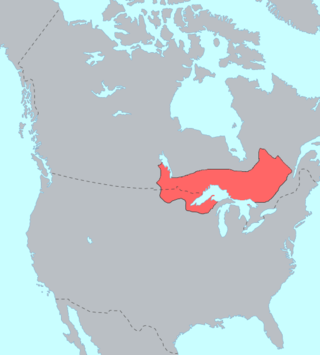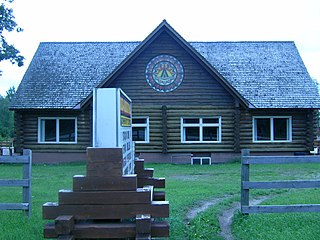Related Research Articles

Leonard Bloomfield was an American linguist who led the development of structural linguistics in the United States during the 1930s and the 1940s. He is considered to be the father of American distributionalism. His influential textbook Language, published in 1933, presented a comprehensive description of American structural linguistics. He made significant contributions to Indo-European historical linguistics, the description of Austronesian languages, and description of languages of the Algonquian family.

Anishinaabe traditional beliefs cover the traditional belief system of the Anishinaabeg peoples, consisting of the Algonquin/Nipissing, Ojibwa/Chippewa/Saulteaux/Mississaugas, Odawa, Potawatomi and Oji-Cree, located primarily in the Great Lakes region of North America.

The Ojibwe, Ojibwa, Chippewa, or Saulteaux are an Anishinaabe people in what is currently southern Canada, the northern Midwestern United States, and Northern Plains. They are Indigenous peoples of the Subarctic and Northeastern Woodlands.

Ojibweoh-JIB-way, also known as Ojibwaoh-JIB-wə, Ojibway, Otchipwe, Ojibwemowin, or Anishinaabemowin, is an indigenous language of North America of the Algonquian language family. The language is characterized by a series of dialects that have local names and frequently local writing systems. There is no single dialect that is considered the most prestigious or most prominent, and no standard writing system that covers all dialects.
David Ramsay was a controversial figure born in Leven, Scotland, who served as a cabin boy in the British Royal Navy, participated in the siege of Louisbourg in 1758 and later acted as a courier, translator and fur and alcohol trader, in part of the lower Great Lakes region consisting of present-day southern Ontario, Canada, and western New York state.

The Anishinaabe are a group of culturally related Indigenous peoples present in the Great Lakes region of Canada and the United States. They include the Ojibwe, Odawa, Potawatomi, Mississaugas, Nipissing and Algonquin peoples. The Anishinaabe speak Anishinaabemowin, or Anishinaabe languages that belong to the Algonquian language family.

Ottawa or Odawa is a dialect of the Ojibwe language spoken by the Odawa people in southern Ontario in Canada, and northern Michigan in the United States. Descendants of migrant Ottawa speakers live in Kansas and Oklahoma. The first recorded meeting of Ottawa speakers and Europeans occurred in 1615 when a party of Ottawas encountered explorer Samuel de Champlain on the north shore of Georgian Bay. Ottawa is written in an alphabetic system using Latin letters, and is known to its speakers as Nishnaabemwin 'speaking the native language' or Daawaamwin 'speaking Ottawa'.
The Severn Ojibwa or the Oji-Cree language is the indigenous name for a dialect of the Ojibwe language spoken in a series of Oji-Cree communities in northern Ontario and at Island Lake, Manitoba, Canada. Ojibwa is a member of the Algonquian language family, itself a member of the Algic language family.

Peter Jones was an Ojibwe Methodist minister, translator, chief and author from Burlington Heights, Upper Canada. His Ojibwa name was Kahkewāquonāby, which means "[Sacred] Waving Feathers". In Mohawk, he was called Desagondensta, meaning "he stands people on their feet". In his youth his band of Mississaugas had been on the verge of destruction. As a preacher and a chieftain, as a role model and as a liaison to governments, his leadership helped his people survive contact with Europeans.
Elbow witches are old women with awls in their elbows in the Ojibwa story of Aayaase, "Filcher-of-Meat". Blinded by cooking smoke, the sisters killed each other in their attempts to kill him for their meal.
Shingebis is a figure in North American-Indian mythology, appearing in various Native American stories that exemplify perseverance and strength in the face of adversity. While the narratives vary, they typically focus on an underdog who defies harsh winter conditions, representing virtues such as courage and resilience. Shingebis is often depicted as a duck, and the stories highlight the protagonist's ability to withstand the cold while others succumb.

Garden River First Nation, also known as Ketegaunseebee, is an Ojibwa band located at Garden River 14 near Sault Ste. Marie, Ontario, Canada.

Madeline Island is an island in Lake Superior. Now part of Ashland County, Wisconsin, it has long been a spiritual center of the Lake Superior Chippewa. Although the largest of the Apostle Islands, it is not included in the Apostle Islands National Lakeshore. It is the only island in the Apostle Island chain open to commercial development and private ownership.
William Jones (1871–1909) was a Native American anthropologist of the Fox nation. Alternate name: Megasiáwa. Born in Indian Territory on March 28, 1871, after studying at Hampton Institute he graduated from Phillips Academy and went on to receive his B.A. from Harvard. When in 1904 he received his PhD from Columbia University as a student of Franz Boas, he became the fourth person to receive a PhD in linguistic anthropology, twelfth person to receive a PhD in anthropology, and first Native American PhD in anthropology.
Basil H. Johnston was an Anishinaabe (Ojibwa) and Canadian writer, storyteller, language teacher and scholar.
The Central Algonquian languages are commonly grouped together as a subgroup of the larger Algonquian family, itself a member of the Algic family. Though the grouping is often encountered in the literature, it is an areal grouping, not a genetic grouping. In other words, the languages are grouped together because they were spoken near one another, not because they are more closely related to one another than to other Algonquian languages. Within the Algonquian family, only Eastern Algonquian is a valid genealogical group.
Truman Michelson was a linguist and anthropologist who worked from 1910 until his death for the Bureau of American Ethnology at the Smithsonian Institution. He also held a position as ethnologist at George Washington University from 1917 until 1932.
Ottawa is a dialect of the Ojibwe language spoken in a series of communities in southern Ontario and a smaller number of communities in northern Michigan. Ottawa has a phonological inventory of seventeen consonants and seven oral vowels; in addition, there are long nasal vowels the phonological status of which are discussed below. An overview of general Ojibwa phonology and phonetics can be found in the article on Ojibwe phonology. The Ottawa writing system described in Modern orthography is used to write Ottawa words, with transcriptions in the International Phonetic Alphabet (IPA) used as needed.
L'Arbre Croche, known by the Odawa people as Waganagisi, was a large Odawa settlement in Northern Michigan. The French called it L'Arbre Croche for the large crooked tree that marked the center of the settlement and was visible for many miles. It covered the region from Harbor Springs to Cross Village in present-day Emmet County, Michigan.

The Tristram and Isoude stained glass panels are a series of 13 small stained-glass windows made in 1862 by Morris, Marshall, Faulker & Co. for Harden Grange, the house of textile merchant Walter Dunlop, near Bingley in Yorkshire, England. Depicting the legend of Tristan and Iseult, they were designed by six of the leading Pre-Raphaelite artists of the day, to an overall design by William Morris. They were acquired in 1917 by Cartwright Hall Art Gallery, which is now part of Bradford Museums & Galleries. They can be seen on display at Cliffe Castle, Keighley.
References
- ↑ Jones, William (1917-19). Ojibwa Texts, vol. ii. Truman Michelson, ed. Leyden, New York: G. E. Stechert & co., pp. 380-393